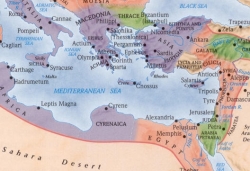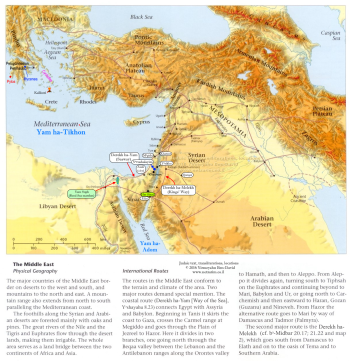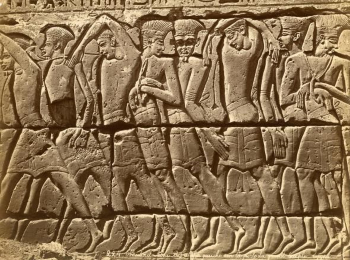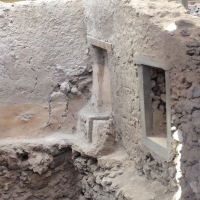
 |
Updated: 2021.12.20 ![]()
Φυλιστῖνοι ![]()
 |
Also Παλαιστίνη, Φιλισταίος & Φιλισταία,
”Πύλος-tine” (Philis-tine/Pales-tine) — the premier Aegean-Mediterranean Hellenist Greek “Sea People” Thalassocracy;![]() of the ancient era, named the principle city of several of their colonies along the eastern Mediterranean coastlands, from the Sinai to Phoenicia, after their Hellenic Mycenaean-Greek home-city of “Πύλος”—which morphed, via transliterations (and occasional reinterpretation) into Hebrew and other languages, as “Philistine”, and their Levant Greek, Hellenist, colony as “Palestine”.
of the ancient era, named the principle city of several of their colonies along the eastern Mediterranean coastlands, from the Sinai to Phoenicia, after their Hellenic Mycenaean-Greek home-city of “Πύλος”—which morphed, via transliterations (and occasional reinterpretation) into Hebrew and other languages, as “Philistine”, and their Levant Greek, Hellenist, colony as “Palestine”.
The (Philistine) Πύλος-ite Hellenic Mycenaean-Greek pottery has long evidenced some previously unknown Philistine connection to Minoan-Greeks. Only recently, however, genetic research,![]()
![]()
![]()
![]() complemented by humanities-archaeologists’ recent excavations,
complemented by humanities-archaeologists’ recent excavations,![]()
![]() has surpassed pottery-based conjectures to clarify the Mycenaean (not Arab) roots of the Philistine’s previously “mysterious” origins.
has surpassed pottery-based conjectures to clarify the Mycenaean (not Arab) roots of the Philistine’s previously “mysterious” origins.
These scientific findings have been occulted by the unprecedentedly audacious wave of contra-reality political claims of modern Arab-”Palestinians” (a now-proven oxymoron).
 |
Aside from modern politically claims, however, there remains another implication that can no longer continue to be ignored: the etymology of the name Philistine and their Palestine colonies, must, finally, be understood from their own Greek language, no longer citing a foreign Semitic (i.e. Hebrew) root. This has long been obvious by the absence of the Greek Παλαιστῖνη & Φυλιστῖνοι to describe פּלִישְׁתִּים in LXX (which deflects to a generalized ἀλλόφυλοι).
We find such an etymological error,![]() for example, in the Egyptian name (conferred by a Pharaonic Princess): □
for example, in the Egyptian name (conferred by a Pharaonic Princess): □![]() -M•s•z (“□-incarnate”). Hebrew-speakers adopted and transliterated this name into their own alephbeit, slightly altering its pronunciation (to Mōsh•ëhꞋ, which means “drawn from water”); thenceforth misunderstanding the name according to their own Hebrew language. The altered name was then further transliterated into other languages; orphaned from its original connections and meaning (e.g. Μωϋσῆς to English “Moses”). In the case of Παλαιστῖνη & Φυλιστῖνοι, while they were originally transliterated from spoken Mycenean-Greek, in a later era it was transliterated—differently—back into Classical Greek, having lost its original Greek association and meaning.
-M•s•z (“□-incarnate”). Hebrew-speakers adopted and transliterated this name into their own alephbeit, slightly altering its pronunciation (to Mōsh•ëhꞋ, which means “drawn from water”); thenceforth misunderstanding the name according to their own Hebrew language. The altered name was then further transliterated into other languages; orphaned from its original connections and meaning (e.g. Μωϋσῆς to English “Moses”). In the case of Παλαιστῖνη & Φυλιστῖνοι, while they were originally transliterated from spoken Mycenean-Greek, in a later era it was transliterated—differently—back into Classical Greek, having lost its original Greek association and meaning.
It’s always been conspicuously discrepant that a people would name themselves with a national name that means burrowers, rollers-in-dirt, intruders, (homeless) emigrant-refugees, intruders or invaders (Hebrew פּלִישְׁתִּי, from the shōrꞋësh פָּלַשׁ![]() ). That’s a Semitic moniker more likely assigned by foreign enemies of the Philistines (like native Kᵊna•an•imꞋ, Ugaritic-Phoenicians of modern Lebanon and adopted by Mi•tzᵊraꞋyim) labeling Aegean Mycenaen-Minoan Greek “Sea People” colonizers. (Colonizing land migrants from the northeast, via the Fertile Crescent, were called •vᵊr•uꞋ.)
). That’s a Semitic moniker more likely assigned by foreign enemies of the Philistines (like native Kᵊna•an•imꞋ, Ugaritic-Phoenicians of modern Lebanon and adopted by Mi•tzᵊraꞋyim) labeling Aegean Mycenaen-Minoan Greek “Sea People” colonizers. (Colonizing land migrants from the northeast, via the Fertile Crescent, were called •vᵊr•uꞋ.)
 |
ca. BCE 2,700 — Minoans from Πύλος, Mycenae, Greece, establish Kal•lisꞋtæ-based Aegean-Mediterranean Seas maritime, merchant marine, international trading empire
ca. BCE 2,004 — Akkadian-speaking![]() Persian Gulf coast
Persian Gulf coast![]() Iraqi
Iraqi![]() from
from ![]() (Ur), Avᵊrâ•hâmꞋ, migrates to disputed border region of the Levant between (Mycenaean Greek-speaking) Philistine & (Semitic-Hebrew speaking) Kᵊna•anꞋ in the southern Levant; purchases and homesteads his regions of Khë•vᵊr•onꞋ and Bᵊeir ShëvꞋa—thereby establishing neonatal Yi•sᵊr•â•eilꞋ.
(Ur), Avᵊrâ•hâmꞋ, migrates to disputed border region of the Levant between (Mycenaean Greek-speaking) Philistine & (Semitic-Hebrew speaking) Kᵊna•anꞋ in the southern Levant; purchases and homesteads his regions of Khë•vᵊr•onꞋ and Bᵊeir ShëvꞋa—thereby establishing neonatal Yi•sᵊr•â•eilꞋ.
ca. BCE 1755 — Yi•sᵊr•â•eilꞋ seeks temporary respite from famine in Mi•tzᵊraꞋyim, but is delayed there more than a century before wresting their freedom.
ca. BCE — Yᵊtzi•âhꞋ, return from Mi•tzᵊraꞋyim to Yi•sᵊr•â•eilꞋ homeland
ca. BCE 722 — Assyrians deracinate Yi•sᵊr•â•eilꞋ (i.e. 10 Northern Tribes), leaving only YᵊhūdꞋâh.
ca. BCE 586 — Bâ•vëlꞋ Exile, YᵊhūdꞋâh (not Palestine) becomes province of
ca. BCE 538 — Koresh, Jr. "the Great", King of Iran,![]() conquers Bâ•vëlꞋ; YᵊhūdꞋâh (not Palestine) becomes an autonomous state of the Iranian
conquers Bâ•vëlꞋ; YᵊhūdꞋâh (not Palestine) becomes an autonomous state of the Iranian![]() Achaemenid Empire.
Achaemenid Empire.
ca. BCE 453 — Iranian![]() King Artakhshast-Artaxerxes issues decree authorizing the rebuilding of the walls of Yᵊru•shâ•laꞋyim, capital of the autonomous YᵊhūdꞋâh (not Palestine) state of the Iranian
King Artakhshast-Artaxerxes issues decree authorizing the rebuilding of the walls of Yᵊru•shâ•laꞋyim, capital of the autonomous YᵊhūdꞋâh (not Palestine) state of the Iranian![]() Empire
Empire
ca. BCE 445 — The oft-touted mention of “Παλαιστῖνη” by BCE 5th century Greek![]() travel-writer, Herodotus, explicitly describes, exclusively, what he saw and heard on location, from local authorities, in his travels (not latest oral stories from sailors and merchants after he returned home). Thus he described, inter alia, Iran’s
travel-writer, Herodotus, explicitly describes, exclusively, what he saw and heard on location, from local authorities, in his travels (not latest oral stories from sailors and merchants after he returned home). Thus he described, inter alia, Iran’s![]() Fifth (Maritime) Tax Satrapy prior even to the decree of Iranian
Fifth (Maritime) Tax Satrapy prior even to the decree of Iranian![]() King Artakhshast-Artaxerxes to authorize rebuilding the walls of Yᵊru•shâ•laꞋyim. Accordingly, at the time of Herodotus’ History, even Yᵊru•shâ•laꞋyim (much less the entire nation of Yi•sᵊr•â•eilꞋ) was only 8 years into rebuilding from its nadir.
King Artakhshast-Artaxerxes to authorize rebuilding the walls of Yᵊru•shâ•laꞋyim. Accordingly, at the time of Herodotus’ History, even Yᵊru•shâ•laꞋyim (much less the entire nation of Yi•sᵊr•â•eilꞋ) was only 8 years into rebuilding from its nadir.
 |
Herodotus also recorded that “Carians“ were a maritime people of the Aegean Sea before being gradually pushed inland.![]() The “Carian“ maritime people seem to be the Turkish (Anatolian) Aegean coastal colony of the Minoan-Philistines. This is further suggested by their headdress. Plutarch (46-120 CE) mentions the Carians as being referred to by the Persians as "cocks" on account of their wearing (apparently feather) crests on their helmets.
The “Carian“ maritime people seem to be the Turkish (Anatolian) Aegean coastal colony of the Minoan-Philistines. This is further suggested by their headdress. Plutarch (46-120 CE) mentions the Carians as being referred to by the Persians as "cocks" on account of their wearing (apparently feather) crests on their helmets.![]()
Further, other researchers have also noted that the writings of Herodotus explicitly and repeatedly specify Παλαιστῖνη to refer exclusively to the coastal strip—not the interior—of the Eastern Mediterranean; i.e. DërꞋëkh ha-Yâm (The Coastal Road, Seaway) Trade Route; the only area that most major powers, seeking tax income, perpetually fought over.![]() As Herodotus’ passage below explicitly specifies, the continuance of YᵊhūdꞋâh in the interior was never severed—even under foreign rule.
As Herodotus’ passage below explicitly specifies, the continuance of YᵊhūdꞋâh in the interior was never severed—even under foreign rule.
E.g., Herodotus’ History, Book 4: "the region I am describing skirts our sea, stretching from Lebanon![]() along the coast of Palestine-Syria till it comes to Egypt, where it terminates"; (Book 7): "[The maritime Minoan Lebanese
along the coast of Palestine-Syria till it comes to Egypt, where it terminates"; (Book 7): "[The maritime Minoan Lebanese![]() and Syrians of Palestine], according to their own account, dwelt anciently upon [islands of] the Mediterranean Sea, but sailing thenceforth, moored on the seacoast of Syria, where they still inhabit—this [seacoast] part of Syria, and all the [coastal] strip extending from hence to Egypt [i.e., DërꞋëkh ha-Yâm (The Coastal Road, Seaway) Trade Route], which is known by the name of Παλαιστῖνη.”
and Syrians of Palestine], according to their own account, dwelt anciently upon [islands of] the Mediterranean Sea, but sailing thenceforth, moored on the seacoast of Syria, where they still inhabit—this [seacoast] part of Syria, and all the [coastal] strip extending from hence to Egypt [i.e., DërꞋëkh ha-Yâm (The Coastal Road, Seaway) Trade Route], which is known by the name of Παλαιστῖνη.”
Thus, the Philistine colony controlled—not established a nation—no more than the Coastal Trade Route for perhaps one century or so after BCE 586 when YᵊhūdꞋâh was at its nadir. Either modern arts-degreed humanities archeologists and historians who conflate much of the interior of Kᵊna•anꞋ as “Arab Palestine” either cannot read logically or they are agenda-driven by pro-Arab politics.
Minoan-Mycenaeans were an Aegean Islands based, Mediterranean-wide, maritime (pre-Alexandrian Hellenist) Greek—not Arab!—nation. They were originally from ancient Mycenaea, Greece, and migrated to the island of Minoa c. B.C.E. 2,700—more than half a millennium before the first 2 Arabs (Yi•shᵊm•â•eilꞋ and Ei•sauꞋ-Ë•dōmꞋ) were even born!
 |
Not coincidentally, modern historians take first notice of this previously-unidentified “Sea People” when they intrude into Southeastern Mediterranean / Middle-Eastern history, streaming ashore in the Egyptian Delta and the southern shores of Kᵊna•anꞋ. (While they also colonized Lebanon, there they blended-in with the •vᵊr•uꞋ, appearing, until these recent genetic discoveries, to be yet another distinct, mysterious, Atlantian-like “Phoenician”, people.) Their colonizing of their ports-of-call around the southeastern rim of the Mediterranean likely mushroomed following the greatest cataclysm in recorded history, in which the Kal•lisꞋtæ eruption (c. BCE ) orphaned these maritime Minoans (“Sea Peoples”) from their Aegean island-capital home.
Prior to the eruption, the Minoan Παλαιστῖνη & Φυλιστῖνοι colonies were certainly reinforced by those from the Mycenaean-Greek capital on the island of (then) Kal•lisꞋtæ.
Archeology of the city of Akrotiri, on Kal•lisꞋtæ island, has shown that, while the eruption blew away ⅔ of the Atlantis-shaped![]() island (which is now sea), killing all life on the island, there were no human remains at Akrotiri when archeologists first excavated the city in 1967. As the island's volcano became increasingly volatile, issuing rumblings, precursor tremors and perhaps gas vents popping-up unpredictably from the ground prior to its ca. B.C.E. eruption, archeology has demonstrated that the Minoans evacuated Akrotiri and their island-capital of Kal•lisꞋtæ, and escaped the eruption.
island (which is now sea), killing all life on the island, there were no human remains at Akrotiri when archeologists first excavated the city in 1967. As the island's volcano became increasingly volatile, issuing rumblings, precursor tremors and perhaps gas vents popping-up unpredictably from the ground prior to its ca. B.C.E. eruption, archeology has demonstrated that the Minoans evacuated Akrotiri and their island-capital of Kal•lisꞋtæ, and escaped the eruption.
Thus, the Minoan Φυλιστῖνοι “Sea People” refugees from the impending eruption streamed ashore, crowding into Crete and colonizing not only Παλαιστῖνη on the southern Mediterranean coast of Kᵊna•anꞋ, but also ballooning their πυλών port-colony of Πύλος, on the northern Sinai shore adjacent to the Egyptian Delta. Moreover, they streamed directly onto the shores of the Egyptian Delta itself—where they mixed with Egyptians and still-captive Yi•sᵊr•â•eil•imꞋ! Thus, Yi•sᵊr•â•eilꞋ also had advance warning that an unprecedented eruption was impending; giving them time to prepare accordingly to use the event as the opportunity to escape the grasp of the Egyptian Par•ōhꞋ.
Now knowing to search for the root meaning in Greek (rather than Hebrew), we know to recognize the similarity of the name of the people to the name of the Mycenaean city of their origin; also the name of at least two of their colonies, “Πύλος.
 |
”Philistines”, then, were the “Sea-Peoples of the Minoan Port-Colonies”; its meaning simply “Minoan Colonists”; the most intellectual, artistic, sophisticated and technologically-advanced people of their era—including the earliest extant toilets connected to indoor-plumbing and municipal sewage system); diametrically opposite to its modern pejorative connotation. (Similar applies to Minoan Cretans.)
Yi•sᵊr•â•eilꞋ is recorded ca. B.C.E. 1600 in stone glyphs in the Egyptian Sinai and documented in the stele of Egyptian Par•ōhꞋ Meren-Ptah recounting his victory over Yi•sᵊr•â•eilꞋ ca. B.C.E. 1231. “The Black Obelisk of Shalmaneser III claims that an Israeli king named Jehu was forced to pay tribute to Assyrian King Shalmaneser III (reign [B.C.E.] 859-824), the obelisk is now in the British Museum.”![]() The Tanakh itself document Yi•sᵊr•â•eilꞋ in the Dead Sea Scrolls as early as B.C.E. the 4th century.
The Tanakh itself document Yi•sᵊr•â•eilꞋ in the Dead Sea Scrolls as early as B.C.E. the 4th century.
As documented earlier in this glossary entry, Arab claims to be “Palestinians” (Philistines, Peleset or Pelishtin) is directly disproven by scientific DNA-proofs that Philistines were of Greek ancestry, not Arabs. See further ![]()
The term “Palestine”, referring to a region of Syria and the eastern Mediterranean coast and Levant generally (not Canaan particularly!) colonized by Philistines, isn’t recorded at all until B.C.E. 5th century; and then it is only a toll road on major caravan routes (i.e. a tax district) to a foreign ruler, irrespective of countries and nationalities. The term never referred to a country or nationality.
Even in 135 C.E., when Israelis (Jews) were expelled from Judea (Jew-dea), the Romans reverted to the previously defined caravan-route tolls (i.e. taxable region) irrespective of any nationality of its resulting Arab squatters.
Yet, the first Muslim Arab doesn’t come into existence until 6 centuries after this!!!
Thus it remained until 1948. From 1948 to 1967, “Palestinian” referred to Jews of the Holy Land; (e/g/, The Jerusalem Post, before then, was the “Palestinian Post”).
Only since the 1967 war have modern Arabs, with no connection ethnically, linguistically or historically to ancient Palestine or Greek Philistines, who squatted in the vacated Levant after the Roman Expulsion of Jews in 135 CE, baselessly arrogated this term to themselves.
Prior to the 1960s, Arabs of the Holy Land insisted they were not “Palestinians” but, rather, "One Unified, Pan-Arab Tribe" that included all Arabs. Arabs of the Holy Land, even by their own insistence until the latter part of the 20th century, are no different from the Arabs in Israel’s 22 neighboring Arab countries.
In fact, in the modern era until 1967, “Palestinian” referred not to Arabs (who were insisting they were no different from their one Pan-Arab tribe) but to Jews returning to their homeland! E.g. The Jewish newspaper “The Palestinian Post” is now known as “The Jerusalem Post”.
There is no connection between modern Middle-Eastern Semitic Arabs who claim to be “Palestinians” and the ancient European Greek Philistines. The only connection Arabs of the Holy Land have to "Palestine" is that the Arab neighbors of the Levant exploited, squatted and occupied the forcibly-vacated Holy Land after the Romans renamed Judaea to “Palestine” and expelled the Jews in 135 C.E. Before that time, the Hellenist Roman—goy•imꞋ— name, "Palestine", referred only to two, non-contiguous regions: one in Syria and the other along the southern coast of the Levant, עַזָּה (occupied by the Greek Philistines). The name “Palestine” had never referred to Israel or Yᵊhūd•âhꞋ located in-between, which had been occupied exclusively by the Israelis/Jews who conquered the Kᵊna•an•imꞋ and absorbed all of their survivors to become the aggregate indigenous people of the Levant. Ever since, only the ignorant, Hellenists and idolatrous miso-Judaics, call it “Palestine”.
So, if these local non-Jews are Philistines, then they aren't Arabs; they're just foreign Greeks with no claim to Israel – fake Arabs!
Modern Arabs occupying parts of Israel are almost entirely Muslim Jihadists implacably determined to annihilate Jews of Israel. Accordingly, they are more accurately designated not by a Roman name having no etymological connection whatsoever to Arabs, and misinforms who they really are, but by a name that truthfully expresses their Arab and Muslim fealty: “Palestanis”.
 |
 |